How to set up a VFX pipeline
Avoid bottlenecks and create visual effects faster and more efficently. Lance Evans explains everything you need to know about creating the perfect VFX pipeline.
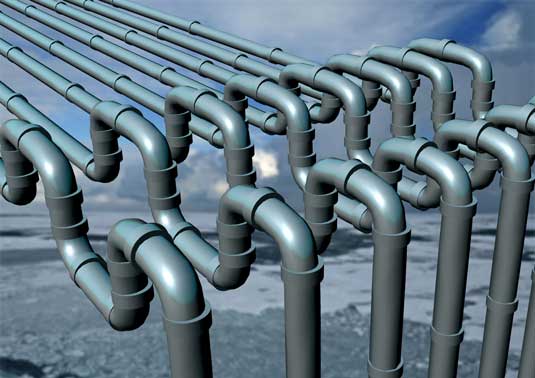
The term 'visual effects (VFX) pipeline' almost sounds like a pre-packaged product of some sort, something Adobe is sure to address in software sometime soon, right? In fact, it's neither a product, nor a technology. Rather it's a workflow, or process.
What is a VFX pipeline?
Essentially we are talking something not so different from Henry Ford's assembly line. That said, the ideal assembly line is rather linear in flow. But try as we may, a CG pipeline tends to be far more organic in nature - that means more complex and with more back and forth.
A pipeline is something that is designed, based on the tasks at hand, the sources of your content, and the type of work to be done. Just like different offices, no two pipeline workflows are the same.
What is consistent from one shop's pipeline to another is the attempt to break down the workflow into logical and functional chunks. This may be done in any one of many ways, and is often something of a hybrid of many ideas. Shops usually have more than one pipeline going on at any time. The trick is making them all work together.
Breakdown by production stages
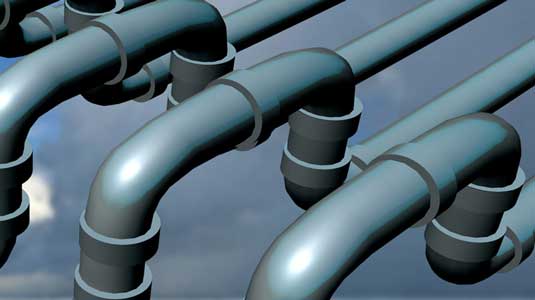
For a more macro view, we may want to break our first pipeline view down into pre-production, production, and post-productions segments.
01. Pre-production
The pre-production stage is when we lay the groundwork for a new project. This usually involves some of the initial and concepting ideas presented to the client during the pitch process. This stage is often handled by smaller skeleton teams, prior to the inevitable swell of freelancers later on. In this stage we may be going heavy with sketches, and early pre-visualizations (“pre-vis”) that can be created in 2D, 3D, video or even “steal-o-matics” (grabbing already published work for presentation purposes only).
The pre-production stage isn't a total toss by any stretch. While much of the material will get re-worked later, the concepts that remain are an important first draft for the production work to come. For example, any 3D modeling and matte painting work can be evolved and finished once the green light is given.
Get the Creative Bloq Newsletter
Daily design news, reviews, how-tos and more, as picked by the editors.
With visual effects work especially, pre-production is a really good time to start working out some of the technologies that will be needed, and dabble with any custom software programming needs, before the crunch of production starts. Also keep in mind that what we are calling “pre” work here, is often done throughout most of a project's life as directions change and needs evolve. So this stage is often on-going and merges into our next segment of work.
02. Production work
Actual production work is the next stage. This is where final source content is created or captured. At this stage the content is raw, but the better you can make your source material, the easier the following stages become. Potential sources for content are ever expanding (see next section). Just as good pre-vis work made production easier, the trick at this stage is to make sure the production parts come together easily in post.
- Huge tip for success: Always be thinking of your buddy that you are handing your work off to! Your job is to always make his/her life easier. Do that, and you have done your job well!
Keep in mind that in this digital age, while we tend to think of visual effects teams in front of a computer doing post work, they really need to be a crucial player in both stages we have discussed thus far.
They must help with planning and advising in pre-vis, and be on set helping video and film teams deliver usable content. Even in 3D animations there is often a distinction between the animators and those doing VFX work, they are different specialties and communications must always be open.
03. Post production
Post production is the last stop on the train. It's where everything gets pulled together and made to work. This is no small order, it is a lot of work. This is why post-production is the often the largest part of a project's timeline.
Post work can go on for months, or even years for feature length films. And there can be large teams working on all the various aspects of it. We've all seen those credit rolls!
Breakdown by content/source
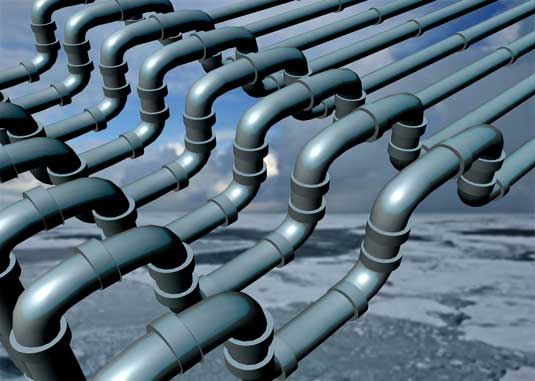
Another way to look at your pipeline is to break it down by job. This is a very practical and necessary approach that looks at all the working cogs in the machine. Think of it as a more micro view of the pipeline.
Using what we learned above, we know that during actual production we will need to capture or otherwise create our source content. Getting down to the nitty-gritty, we know that means we may have source from any of the following:
- movie film
- video (various sources and qualities)
- still photography
- HDRI photography
- matte painting
- 3D production (visual effects and animation)
- audio tracks (dialog)
- audio effect tracks (foley work)
- music
...and perhaps many others.
Let's break it down one step further and recognize that even each one of these jobs - or cogs in the machine - has its very own pipeline that must be dealt with.
For example, look at video. It first needs to be filmed, then has to go through a transfer process, then brought into an editing system. At some point it will likely cross over to needing compositing work, will have many other items brought into it (audio, music, etc.), be sent to for final work by a colourist, and of course it will ultimately need to be exported, perhaps needing a range of outputs for various target platforms (web, broadcast, etc.).
That is quite a pipeline, no? And it interleaves with similar workflows from all the other disciplines.
Keeping the pipelines flowing
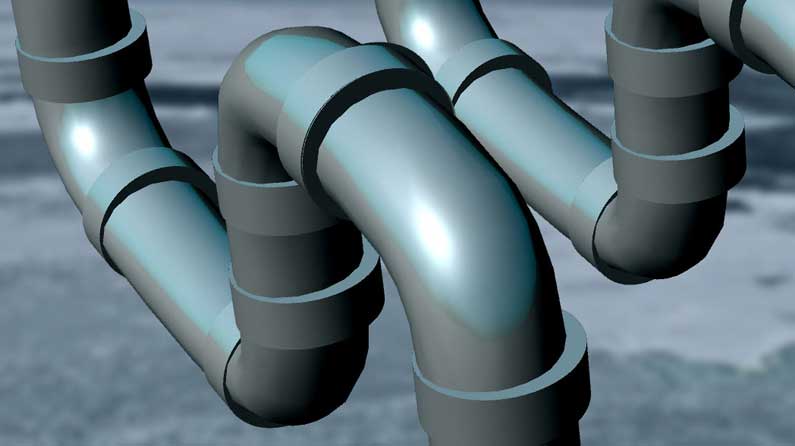
Keeping this whole process, with its huge amount of detail, all moving along is not easy thing to do in a big shop. Frankly, it can be just as difficult in a small shop as well. When almost each project is different, it creates the need to always be updating your pipeline in some way. Remember, almost nobody's pipeline is a static thing.
The key to making yours work starts with a full understanding of the entire process, the macro overview. This allows the person in charge to make major flow changes when needed, or when technology comes along that allows for improvements (which we know happens every 15 minutes!).
But the granular or micro view is just as important. Every member of the team must have a commitment to keeping the system working, because CG and VFX pipelines are ultimately fragile human constructs that need a good deal of care, and a good deal of thought.
Everyone on the team should have a say, and the opportunity to share their ideas on ways to improve the process. A pipeline design should never be a dictum from above, it's always a team effort, just like the projects themselves. And the individual team members know their own micro pipelines better than anyone else.
Where to learn more
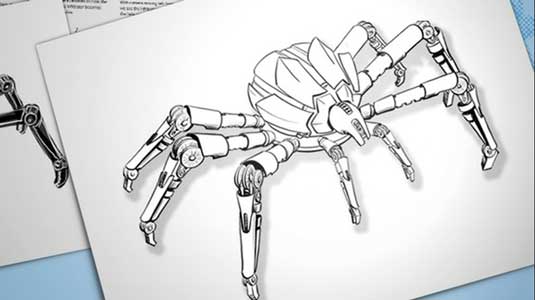
To learn more, take a look at some of these further reading sources:
- The VES Handbook of Visual Effects: Industry Standard VFX Practices and Procedures. Edited by Jeffrey A. Okun, Susan Zwerman, published by Focal Press.
- Blog: The Art of CG Supervision
- Blog post: Andrew Whitehurst on the visual effects pipeline
- PDF download: Global Visual Effects Pipelines An Interview with Hannes Ricklefs
- Purchased tutorial: 'Infiltrator' Production Pipeline
Words: Lance Evans
Lance Evans is creative director of Graphlink Media. He has written books on 3D, and produced the 3DNY Seminars for Apple and Alias.
Delivered in conjunction with ZED!
This content was produced in collaboration with HP & Intel as part of ZED - a Pop-Up Studio for the Creative Community held in Soho, London. For more information about ZED and any future events see here.

Thank you for reading 5 articles this month* Join now for unlimited access
Enjoy your first month for just £1 / $1 / €1
*Read 5 free articles per month without a subscription

Join now for unlimited access
Try first month for just £1 / $1 / €1

The Creative Bloq team is made up of a group of art and design enthusiasts, and has changed and evolved since Creative Bloq began back in 2012. The current website team consists of eight full-time members of staff: Editor Georgia Coggan, Deputy Editor Rosie Hilder, Ecommerce Editor Beren Neale, Senior News Editor Daniel Piper, Editor, Digital Art and 3D Ian Dean, Tech Reviews Editor Erlingur Einarsson, Ecommerce Writer Beth Nicholls and Staff Writer Natalie Fear, as well as a roster of freelancers from around the world. The ImagineFX magazine team also pitch in, ensuring that content from leading digital art publication ImagineFX is represented on Creative Bloq.
